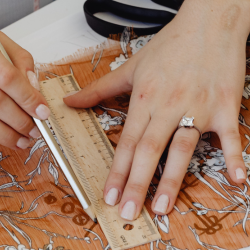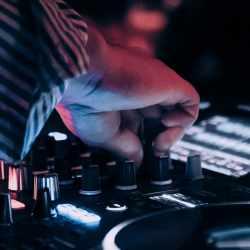Portrait photography is one of the most expressive genres in photography, capturing not just faces but emotions, personalities, and stories. It goes beyond a simple photograph, offering a glimpse into the subject’s character and mood. Whether shot in a studio, outdoors, or through candid moments, portrait photography is a timeless art form that connects people through visuals.
In this article, we’ll explore what portrait photography is, why it matters, its different types, how to choose the right portrait photography background, essential equipment, techniques, and some of the most famous portrait photographers to inspire your journey.
What is Portrait Photography?
Portrait photography focuses on capturing the personality, emotions, and expressions of a person or group of people. Unlike regular snapshots, portraits aim to tell a deeper story through composition, lighting, and background.
The goal of portrait photography is not only to show how someone looks but also to reflect who they are, making it one of the most impactful forms of visual storytelling.
Importance of Portrait Photography in Art and Media
Portraits have been a key part of art and culture for centuries. From painted royal portraits to today’s professional headshots, they remain essential in representing identity, status, and personality.
In modern times, portrait photography plays a crucial role in media, advertising, fashion, and even social media branding. It helps individuals and businesses create strong impressions while keeping the art of human storytelling alive.
Types of Portrait Photography
There are several styles of portrait photography, each with its own charm and technique. Here are some of the most popular ones:
Traditional Portrait Photography
This is the classic form of portraits—posed, carefully lit, and focused on highlighting the subject’s best features. It’s commonly used for formal occasions like graduations or professional headshots. Traditional portraits often emphasize elegance, professionalism, and timeless appeal, making them a go-to choice for capturing significant milestones.
Environmental Portrait Photography
Here, the background plays a big role in telling the story. For example, a chef photographed in the kitchen or an artist in their studio. The portrait photography background becomes part of the subject’s identity.
Candid Portrait Photography
Candid portraits capture natural expressions without asking the subject to pose. These portraits often feel authentic and emotionally powerful, as they capture moments in their purest form.
Check in Detail: Candle Light Portrait Photography
Lifestyle Portrait Photography
A blend of candid and environmental photography, lifestyle portraits show people in real-life situations. Families, couples, and influencers often use this style to showcase daily life with an artistic touch.
Creative and Conceptual Portrait Photography
This style breaks traditional rules by using props, costumes, dramatic lighting, or digital effects. It’s often used in advertising and fine art to create striking, imaginative portraits.
Portrait Photography Background – How to Choose the Right Setting
The background of a portrait can make or break the photo. A well-chosen portrait photography background complements the subject and adds depth to the image. Here are some popular options:
Natural Light Backgrounds
Using natural light in parks, gardens, or near windows gives portraits a soft and authentic look. It’s one of the most cost-effective and flattering background choices. The changing intensity of sunlight throughout the day also adds variety, giving you golden-hour warmth or crisp daylight tones.
Studio Portrait Photography Backgrounds
Studios allow controlled lighting and customizable backdrops like solid colors, textures, or abstract designs. These backgrounds are great for professional and creative shoots. Plus, studios minimize distractions, letting the focus remain solely on the subject’s expression and styling.
Outdoor Portrait Photography Backgrounds
Outdoor settings like cityscapes, beaches, or forests provide variety and mood to portraits. The environment can enhance the story behind the image, making it more engaging. Seasonal changes outdoors also bring fresh opportunities for creative portraits with natural elements.
Creative Backgrounds for Portrait Photography
Experiment with murals, neon lights, or blurred bokeh effects for a unique and artistic feel. Creative backgrounds help portraits stand out and add personality to the shot. They’re also a great way to reflect the subject’s individuality and mood, making the portrait more memorable.
Essential Equipment for Portrait Photography
While creativity matters most, the right equipment helps capture stunning portraits with precision.
Camera and Lenses
DSLRs and mirrorless cameras are preferred for portrait photography. A 50mm or 85mm prime lens is ideal as it creates beautiful background blur while keeping the subject sharp. Investing in the right gear ensures higher quality and more professional results.
Lighting Setup
Softbox lights, ring lights, or natural reflectors help balance shadows and highlights, ensuring the subject looks flattering. Lighting is crucial in setting the mood of a portrait and can completely transform the final outcome.
Tripods and Reflectors
Tripods ensure stability for longer shoots, while reflectors bounce light onto the subject, softening shadows and enhancing details. These tools also make the shooting process smoother and more efficient for photographers.
Portrait Photography Techniques and Tips
Mastering techniques can elevate your portraits from simple to stunning.
Mastering Poses and Angles
Encourage natural poses and try shooting from different angles. Slight head tilts or varied eye levels can make portraits more dynamic. Experimenting helps capture the subject’s personality more authentically.
Using Depth of Field Effectively
Blurring the background while keeping the subject sharp makes them the focal point. This technique is especially useful when the portrait photography background is busy or distracting. It also adds a professional touch to even simple setups.
Framing and Composition in Portrait Photography
Use the rule of thirds, leading lines, and natural frames like doorways or windows to guide the viewer’s eye toward the subject. Strong composition ensures portraits look visually balanced and engaging.
Post-Processing for Portraits
Editing software like Lightroom or Photoshop helps enhance skin tones, adjust lighting, and add finishing touches for a polished look. Subtle retouching can elevate an image without making it look artificial.
Also Read About: Advanced Photography Techniques
Famous Portrait Photographers to Learn From
Learning from renowned portrait photographers can give you insights into different styles, techniques, and creative approaches. Their work serves as inspiration for both beginners and professionals looking to refine their craft.
- Annie Leibovitz – Iconic Celebrity Portraits: Known for her bold, dramatic celebrity portraits, Annie Leibovitz blends art and storytelling with unique lighting and composition.
- Richard Avedon – Black and White Portrait Mastery: Avedon’s minimalistic black-and-white portraits reveal raw emotions and became iconic in fashion and fine art
- Steve McCurry – Storytelling Through Portraits: Best known for the “Afghan Girl” photo, McCurry’s portraits are rich in color, emotion, and cultural storytelling.
- Dorothea Lange – Human Emotions Captured in Portraits: Her portraits during the Great Depression documented human struggle and resilience, making her one of the most impactful photojournalists.
- Platon – Contemporary Political and Cultural Portraits: Platon’s portraits of world leaders and cultural icons are bold, close-up, and thought-provoking, capturing power and personality in every frame.
Common Mistakes to Avoid in Portrait Photography
- Ignoring the background, which can distract from the subject
- Using harsh lighting without softening shadows
- Over-editing, which makes portraits look unnatural
- Not communicating with the subject, resulting in stiff poses
- Shooting only from eye level, missing creative angles
Enhancing Skills in Portrait Photography
Portrait photography is more than just taking pictures of faces—it’s about capturing stories, emotions, and personalities. By experimenting with different backgrounds, techniques, and styles, you can continually improve your skills. For those serious about mastering the craft, enrolling in a structured Photography Course Online can provide professional training and practical knowledge to take your portraits to the next level.
FAQs
What is portrait photography and its main purpose?
Portrait photography is about capturing the personality, mood, and story of a subject, going beyond just appearance.
What are the different types of portrait photography?
Traditional, candid, lifestyle, environmental, and creative portrait photography are the most popular types.
How do I choose the right portrait photography background?
Consider the mood you want to convey. Natural, studio, outdoor, or creative backgrounds each offer unique advantages.
Which camera and lens are best for portrait photography?
DSLR or mirrorless cameras with prime lenses like 50mm or 85mm are highly recommended.
What lighting setup works best for portrait photography?
Soft, diffused light such as natural light or softboxes works best for flattering portraits.
What are some beginner tips for portrait photography?
Focus on the eyes, experiment with depth of field, and use natural poses for authentic results.
How can I edit portraits to make them look professional?
Use editing software to balance tones, retouch skin gently, and adjust exposure without overdoing it.
Who are some famous portrait photographers to get inspiration from?
Annie Leibovitz, Steve McCurry, Richard Avedon, Dorothea Lange, and Platon are great sources of inspiration.






















